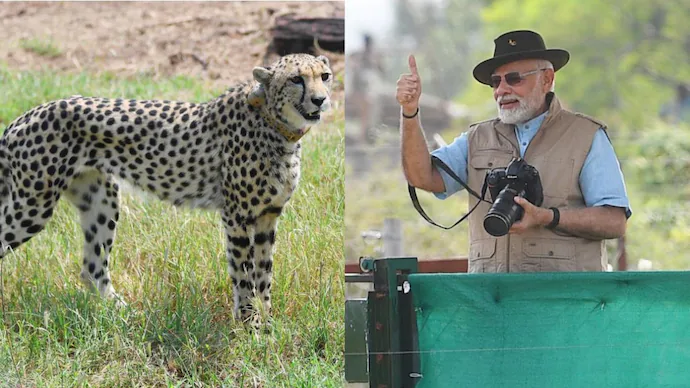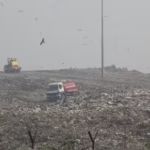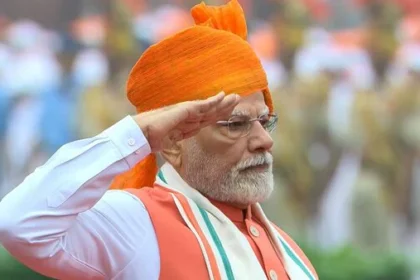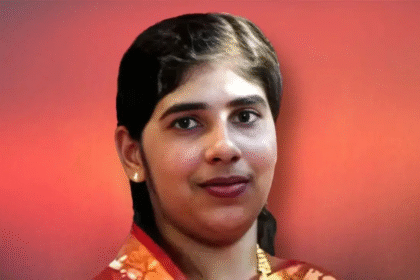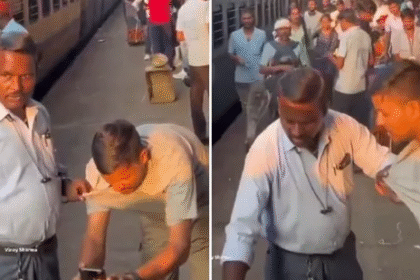Is Modi’s Cheetah Project Working? Doubts Grow Over the Fate of Namibian Cheetahs in India
Bengaluru: Recently, Prime Minister Narendra Modi while on a visit to Namibia thanked the country for its “gift” of eight African cheetahs to India.
“India and Namibia have a powerful story of cooperation, conservation and compassion, when you helped us in reintroducing cheetahs in our country,” Modi said in his address at the joint session of the Namibian parliament in Windhoek on July 9.
“They are happy and have adapted well in their new home. They have grown in numbers as well. Clearly, they are enjoying their time in India,” Modi said. “We are deeply grateful for your gift. I had the privilege of releasing them in the Kuno National Park. They have sent a message for you: inimaa aaishe oyilii naavaa: Everything is fine.”
Modi’s ‘happy’ cheetahs
But if you asked cheetah Nabha, it would possibly disagree. It’s dead, you see. Nabha died just about a week ago, on July 12, three days after Modi said that the Namibian cheetahs were “happy”.
It turns out that Nabha had already been suffering for a week, and that it had met with a grievous injury well before Modi’s statement that everything was fine with the Namibian cheetahs.
According to an official statement on July 12, Nabha died “possibly” due to injuries sustained during a hunting attempt a week before, inside its quarantine enclosure or boma (a fenced area) within Madhya Pradesh’s Kuno National Park.
Nabha was one of the eight adult African cheetahs that arrived in Kuno from Namibia in September 2022, part of the first batch of cheetahs to reach India from Africa for India’s ambitious cheetah reintroduction programme, Project Cheetah.
The project aims to introduce African cheetahs into select grassland habitats in central India. When the animals arrived from Namibia on September 17 that year on Modi’s birthday, the prime minister himself released them into their enclosures within the park.
The use of the word “possibly” in the statement announcing Nabha’s death suggests that authorities are unclear about what caused Nabha’s injuries – a strange feat considering that the animals, especially those in enclosures, are being regularly monitored “24×7” by a large team.
Uncertainty also shrouds the previous cheetah death – again, that of a Namibian cheetah. Nearly a year ago on August 27, authorities found the adult male Pavan dead near the edge of a nala, which is typically a small forest stream. The nala was running full due to rains, an official statement said.
“Preliminary cause of death seems to be due to drowning,” it read. It said that further details would emerge after authorities receive the post-mortem report, but officials have not yet shared that information with the press.
Experts have raised doubts on this cause of death: because though cheetahs generally avoid water, they are usually good swimmers, as this photograph shows.
Around seven months before Pavan’s death, another Namibian male cheetah had died in Kuno. Shaurya died of a “weakness” on January 14, 2024. Authorities had noticed the cheetah displaying symptoms of “incoordination and staggering” in its gait within its enclosure. Though it received medical attention, the animal did not make it.
The exact cause of death would be ascertained only after the post-mortem report, the official statement said. The report, if there was one, was not shared with the media.
The previous death of an adult cheetah was also of an individual that came from Namibia. Dhatri, a female, died on August 2, 2023. Authorities found it dead in the wild (Dhatri and several other adult cheetahs had been released in the wild by then). The official statement said that a post-mortem was being conducted to ascertain the cause of death. No details came.
Until, in a series of posts on social media on August 3, the Namibia-based Cheetah Conservation Fund that was then assisting Project Cheetah said that post-mortem results showed that Dhatri had died due to an infection caused by a maggot infestation or myiasis, the same way that two other male cheetahs brought in from South Africa had just died at that time.
But the first Namibian cheetah to die in Kuno – also the first adult cheetah to die in the park – was Sasha. On March 27, 2023, just about six months after it arrived from Namibia, Sasha died due to chronic renal failure.
Deaths of cubs and stone-pelting
In all, five of the eight adults that came in from Namibia are now dead. The three Namibian cheetahs now alive in Kuno are Aasha, Jwala and a male named Gaurav.
One could argue that the three Namibian cheetahs that are alive may possibly be doing well. The two females, Aasha and Jwala, have given birth to three litters between each other. Authorities have put this down to the “success” of the programme.
Jwala was the first adult cheetah to give birth on Indian soil. It gave birth to four cubs in March 2023. However, three cubs from this litter died due to “heat stress and dehydration”. In December 2023, Aasha gave birth to three cubs. A month later, in January 2024, Jwala gave birth once again, to four.
Aasha and its three cubs as well as Jwala and its four cubs are doing well enough to now roam the wild in Kuno. But there’s been trouble on this front too.
Videos that surfaced in March this year on social media showed villagers pelting Jwala and her four cubs with stones on the outskirts of the Behardha village near Kuno. The five cheetahs also tried to take down a calf but villagers armed with sticks chased them away.
Ecologists had warned – even as the first batch of cheetahs were brought in, in September 2022 – that the release of the animals in the wild could aggravate human-wildlife conflict in the area, because cheetahs in many parts of Africa are known to prey on livestock.
What about the rest of the cheetahs?
Of the 12 adult cheetahs that came in from South Africa, four are dead.
Uday, a male, died in April 2023 due to what authorities have called “cardiopulmonary failure”. However, authorities have not shared the details of what caused this failure.
Less than a month later, a female named Daksha died in a “mating injury”. Experts criticised the authorities on this, saying that they were in too much of a hurry to get cheetahs to mate and produce offspring.
On July 11 and 14 the same year, Kuno lost two more South African cheetahs: two males, Tejas and Surya. Veterinary specialists who were then associated with the project had said that both males died due to septicaemia, an infection of the blood. However, the Indian government later went on record saying that the animals died of “natural causes”.
Currently, eight adult cheetahs that came in from South Africa are alive. Females Nirva, Gamini, Veera and Dheera, as well as two males Vayu and Agni, are in Kuno.
Two other males (Prabhas and Pavak) from South Africa are currently in the Gandhi Sagar Wildlife Sanctuary, a protected area near Kuno where they were released on April 20 this year.
Females from South Africa have also given birth to cubs, but some of these cubs too have died just like their Namibian counterparts.
In March 2024, Gamini gave birth to a litter of six. Two of these died in the months that followed, one due to a spinal injury.
In November 2024, Nirva gave birth to a litter of two; authorities found both cubs dead a few days later.
Authorities released Gamini and its four cubs in the wild in March this year. Cheetahs Dheera, Agni and Vayu were already released in the wild by then.
In February this year, Veera gave birth to two cubs. And in April, Nirva once again gave birth, to a litter of five.
However, two cubs from Nirva’s litter died, sometime before June 15. Authorities did not announce these deaths in a press note, as is the norm. Field director and assistant principal chief conservator of forests Uttam Kumar Sharma confirmed the news of their deaths on July 18.
Even though authorities are supposedly monitoring the cheetahs constantly, they do not know the cause of the cubs’ death. The cause of deaths is not certain as the bodies could not be retrieved, Sharma said. Their deaths could have been due to the harsh heat, as the cubs died in peak Kuno summer – but again, there is no way to ascertain this because authorities are “not sure”.
As of July 18, of the 26 cheetah cubs born on Indian soil, nine have died and 17 survive. And of the 20 adult cheetahs that came in from both Namibia and South Africa, only 11 now survive.
So while some of the cheetahs are managing to hang on, “everything” is not as “fine” as Modi claimed in Namibia either. Nine of the adult cheetahs and nine of the cubs are unlikely to be “happy”, or “enjoying their time in India”: they are dead.


